New perk: Easily find new routes and hidden gems, upcoming running events, and more near you. Your weekly Local Running Newsletter has everything you need to lace up! Subscribe today.
Road-racing super shoes—boasting a thick stack of soft, hyper-responsive foam paired with an embedded, curved, rigid plate—have burst onto the running scene, delivering some of the most efficient rides in running shoe history. It makes sense, then, that trail runners have been eager to gain the same performance edge from trail running super shoes. But it’s not as simple as plug-and-play: The same materials and designs that create the trampoline-like bounce of super shoes can turn against an off-road runner when the terrain gets technical.
When embedded in thick, plush foams, a stiff plate (carbon or otherwise) acts as a stabilizer, reducing the wobble and directing the rebound where it’s most productive—as long as the footing underneath remains consistent. However, on uneven, unpredictable terrain, that same plate rigidity can create a precarious platform, causing the shoe to tip on landing or bounce in unproductive and dangerous ankle-twisting directions instead of driving you forward. This makes the balance between cushioning, stiffness, and control especially tricky for shoe designers trying to create a plated trail running super shoe.
To solve the tippy platform problem, designers have gotten creative with the materials and shapes of plates in trail shoes to increase flexibility and allow for greater adaptability. Instead of rigid, full-length plates, they have introduced slightly flexible, split designs that are often forked in the forefoot, heel, or both, allowing independent movement of parts of the plate on uneven ground. The modifications that allow these plates to adapt, however, can reduce their effectiveness at controlling and directing the foam for propulsive rebound—which of course is the biggest value proposition of super shoes to begin with.
While there’s ongoing debate about whether plates in trail shoes offer the same proven performance benefits as they do on the road, every expert I’ve spoken with agreed that they still serve a purpose. Long before carbon plates revolutionized road running shoes for speed and efficiency, the best trail running shoes were using plates in the midsole for a very different purpose: protecting runners’ feet from sharp rocks. Plates still improve protection as well as add stability—some models even feature winged plates that extend through the sides of the midsole to reduce lateral roll. And trail shoe plates enhance the foam’s rebounding propulsion, even if not to the same degree as road models.
One group who believes the shoes deliver performance advantages are elite runners, who continue to turn to trail running super shoes when it matters most: on race day. At the 2025 Western States Endurance Run, for example, more than half of the top ten male and female runners wore a plated trail shoe. are becoming more widespread.
Are you curious if a plated trail shoe might benefit your own running? Whether you’re training for an ultra or just want a little extra snap on your local trails, we’ve tested and compiled the best trail running super shoe options available today.
Best Trail Running Super Shoes: At a Glance
- Adidas Terrex Agravic Speed Ultra ($160)
- Altra Mont Blanc Carbon ($260)
- Hoka Tecton X3 ($275)
- Nike Ultrafly ($175-$260)
- North Face Pro 3 ($250)
- On CloudUltra Pro ($260)
- Puma Deviate Nitro Elite Trail ($230)
- How to Choose Trail Super Shoes
- Trail Super Shoe FAQ
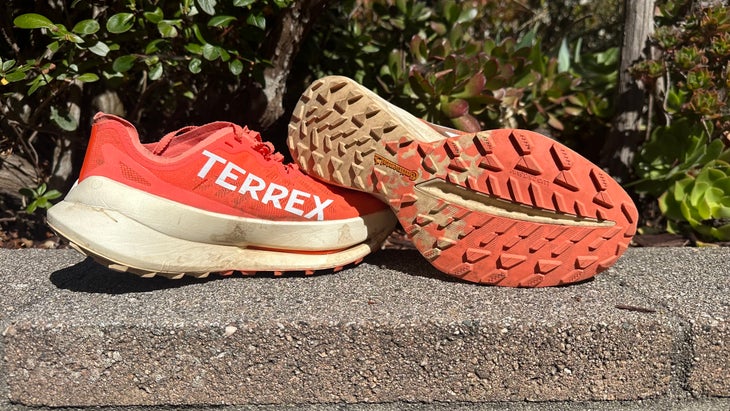
Adidas Terrex Agravic Speed Ultra
$126-$180 at Backcountry (Women’s) $160 at Backcountry (Men’s)
Weight: 9.5 oz (men); 8.1 oz (women)
Stack Height: 38–30 mm
Drop: 8 mm
Pros and Cons
⊕ High energy foam is extremely bouncy
⊕ Rocker profile amplifies forward propulsion
⊕ Individual energy rods adapt to uneven surfaces
⊗ Soft heel cup can allow heel to lift
In the testing experience of our team, the Adidas Terrex Agravic Speed Ultra came the closest of any trail shoe yet to deliver the efficiency gains seen on the road—earning it our 2024 Editor’s Choice award as one of the best trail running super shoes currently available. Designed specifically for speed at the Western States Endurance Run, where the trail is often fairly smooth, the Speed Ultra stands out for its extra-responsive, gas-infused TPEE Lightstrike Pro midsole and embedded Energy Rods, which our testers felt enhanced both propulsion and stability.
Unlike a solid plate, the Energy Rods use Pebax prongs that spread out from the midfoot, four in the forefoot and two in the heel. These rods mimic the foot’s natural bone structure and flex independently, allowing the shoe to adapt to uneven terrain while delivering road-shoe-like energy return and snappy push-off.
I found this design performed well through off-camber and moderately technical terrain—for such a tall-stacked shoe—but the Speed Ultra shone best when I let it rip on a smooth trail without having to tiptoe through rocky terrain. The pronounced rocker-shaped profile lends itself to a midfoot landing, then smoothly rolls you forward as your weight shifts, creating an effortless, propulsive transition through toe-off.
The upper is made with a thin, breathable, and abrasion-resistant woven mesh, reinforced with strategically placed overlays for added durability and support. True to its racing DNA, the tongue, heel collar, and counter are stripped down with minimal padding to keep weight low. While it’s not a comfort-focused upper, it never felt uncomfortable. My only complaint was the lack of a firmer heel, which led to a slight heel lift.
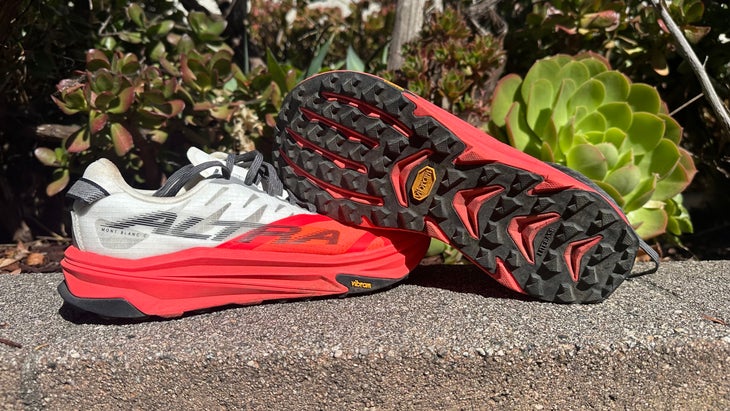
Altra Mont Blanc Carbon
$260 at REI (Women’s) $260 at REI (Men’s)
Weight: 10.9 oz (men); 8.8 oz (women)
Stack Height: 29-29 mm
Drop: Zero mm
Pros and Cons
⊕ Sticky outsole
⊕ Great midfoot lockdown with a roomy toe box
⊗ Less cushioned than other trail super shoes
Given that the Mont Blanc Carbon is the only zero‑drop, carbon‑plated trail racer out there, natural-ride aficionados will be relieved to know that this shoe absolutely rips. Sporting just 30 mm of stack height, about 7 mm slimmer than any other plated trail shoe in the heel, it kept our testers balanced and grounded, while still protected and propelled.
Under the hood, Altra uses a dual-density midsole to fine-tune the ride. The core of the midsole is a responsive TPE foam for a bouncy feel we experienced underfoot. That is encapsulated by a more durable and firmer EVA foam for stability. Embedded in the middle, a somewhat flexible Carbinex carbon fiber plate adds a bit of snap. The result is a smooth, cushioned ride. While it isn’t the liveliest supershoe in the dirt, its blend of roomy toe box comfort, dependable grip, and moderate snap makes it a strong pick for 50k to 100k efforts on mixed terrain, especially if you’re already an Altra fan.
Altra kept the mesh upper clean and minimal, giving it a lightweight, racey feel. A lightly padded molded heel collar adds a touch of comfort around the heel, but can allow some heel lift. The tapered midsection fades away to Altra’s famously wide toe box.
Keeping you surefooted in most types of terrain is Vibram’s Litebase Megagrip with 3.5 millimeter lugs, which feel uncannily sticky on dry rock, almost like they are made of climbing rubber.
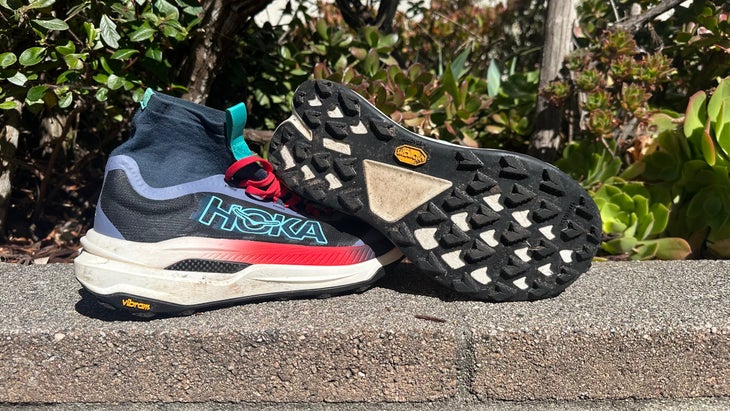
Hoka Tecton X3
$275 at Hoka (Women’s) $275 at Hoka (Men’s)
Weight: 10.0 oz (men); 7.9 oz (women)
Stack Height: 40-35 mm
Drop: 5 mm
Pros and Cons
⊕ Stable for such a cushioned shoe
⊕ Works well as an everyday shoe as well as a racer
⊗ Above-the-ankle knit gater gets hot
Designed off a prototype Jim Walmsley used to become the first American male to win UTMB back in 2023, the Tecton X3 is Hoka’s tip-of-the-spear performance trail shoe. Underfoot is a dual-layer PEBA-based foam, soft up top, firmer below, surrounding parallel carbon plates that are designed to adapt to off-camber terrain. Of all the plated shoes we tested, the Tecton X3 helped us stay composed in technical terrain the best, as long as we picked a clean line.
Surprisingly, despite the towering 40 millimeters under the heel, the ride felt stable and controlled. You still have to be conscious of your foot plants to avoid the dreaded rolled ankle, but certainly less so than in other trail super shoes.
Up top, Hoka wraps the foot in a full knit gaiter reinforced with Matryx mesh. We were wary of the above‑ankle cuff at first, yet after a couple of runs it disappeared from notice, and some skeptics even came to like it for its ability to keep dust and debris out.
Where the shoe meets the dirt, Hoka went with the best, a Vibram Megagrip Litebase outsole with 4-millimeter lugs. It bites hard on everything short of sloppy mud, where deeper teeth would help. For most mountain courses, the grip is exactly what you need. Despite its race‑day billing, the shoe stays smooth and stable enough for everything from recovery jogs to long adventure runs.
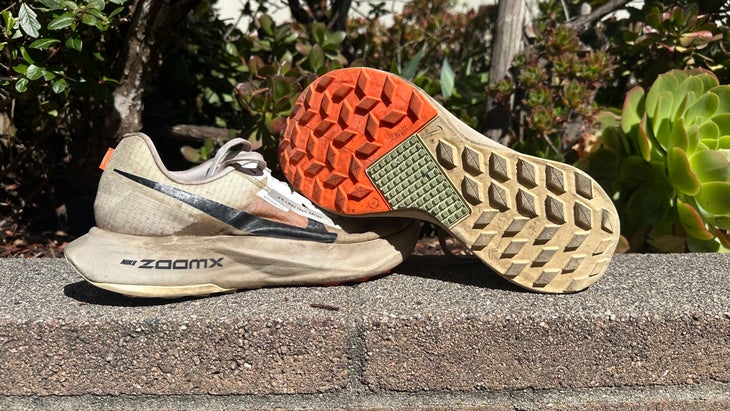
Nike Ultrafly
$199-$248 at Amazon (Women’s) $175-$260 at Amazon (Men’s)
Weight: 9.9 oz (men); 8.7 oz (women)
Stack Height: 38.5-30 mm
Drop: 8.5 mm
Pros and Cons
⊕ Very stable
⊕ Great for cruising tame trails
⊗ Lacks adequate toe protection
Nike popularized carbon-plated shoes with the groundbreaking Vaporfly 4%, a road racer that redefined performance and kicked off the super shoe era. Their trail-specific carbon fiber model, the Ultrafly, adapts this groundbreaking tech for off-road terrain. At the heart of the Ultrafly is Nike’s highest-energy PEBA-based foam, ZoomX, with a forked carbon plate sandwiched inside. The ZoomX is encased with a firmer, more durable coating that contains the foam and guards against debris punctures.
Underfoot, the combo of foam and plate results in a well-cushioned ride that feels surprisingly stable and close to the ground for a 38mm stack height shoe. It’s not the most nimble, but for ultra-long distances like 50k, it hits the sweet spot, optimizing the balance of energy return and leg-saving cushioning.
If you find yourself in technical terrain, you’ll notice a few kinks. The rip‑stop upper offers minimal toe protection, and the wide forefoot doesn’t lend itself to picking through really rocky terrain with precision. Still, the midsole with embedded plate provides a good amount of underfoot protection to plow over moderately rocky terrain like a Jeep 4×4.
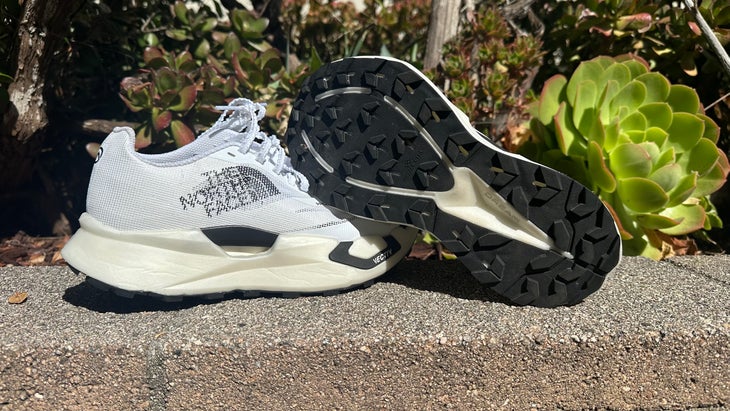
North Face Summit Series VECTIV Pro 3
$250 at North Face $250 at Zappos
Weight: 10.4 oz (unisex, men’s 9, women’s 7)
Stack Height: 37-31 mm
Drop: 6mm
Pros and Cons
⊕ Excellent protection and support
⊕ Exells on long outings
⊗ Feels bulky and overbuilt
When North Face came out with the original Summit Series VECTIV Pro, it was one of the first carbon-plated trail shoes to market, quickly earning our highest praise of winning the Editor’s Choice award. Now two iterations later, The North Face continues to innovate its highest-performance ultra-distance shoe. The most notable difference is a unique stacked plate system. Instead of one plate embedded in the midsole, there are two: a lower, carbon fiber plate is designed for propulsion, and a second, made from recycled carbon, helps stabilize.
Encompassing the plate system is North Face’s nitrogen-infused DREAM foam, now 4 millimeters thicker than the previous version, shaped with an aggressive rocker profile. The noticeable curved shape forces a smooth roll forward with each foot strike.
My one gripe: The stacked plates and extra foam make the midsole feel overbuilt and a touch heavy. It’s less nimble than agile‑minded racers and shines most on long, steady efforts where you can lock into cruise control.
The upper is a tough-skinned mesh with a supportive heel counter that breathes well. It can get a little abrasive if wearing ankle-height or ultra-thin socks, but nothing a thick pair of crew socks didn’t fix.
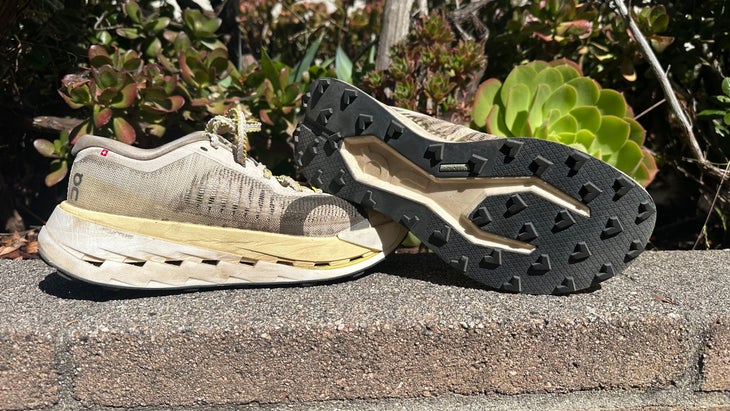
On CloudUltra Pro
$260 at REI (Women’s) $260 at REI (Men’s)
Weight: 9.7 oz (men); 7.7 oz (women)
Stack Height: 38.5-32.5 mm
Drop: 6 mm
Pros and Cons
⊕ Highly breathable upper
⊕ Responsive and stable two-layer midsole
⊗ Porous upper allows dust and dirt through
If you’re considering an On Running trail shoe, this is the one we’d recommend. On took everything we love about its premier carbon-plated road super shoe—bouncy midsole, smooth ride—and retro-fitted it for the trails. It features their PEBA-based Helion HF foam, with a softer layer underfoot for comfort and a firmer layer below for stability, separated by a responsive nylon/fiberglass plate that adds a snappy, fun feel.
Like most taller-stack trail shoes, it really comes alive on smoother terrain where you can open up your stride without the fear of navigating ankle-turning obstacles. As the name implies, it’s built for ultra distances. The combination of plush cushioning and energetic rebound helps you squeeze every last mile out of your tired legs. We were surprised by how well it also handled pavement, making it a solid pick for road-to-trail routes and long days that start from your front door.
The upper, which is made with a tough-skinned, airy weave, holds the foot securely without adding extra weight. It’s exceptionally breathable and moisture-wicking thanks to its see-through weave, but it allows dirt and dust to penetrate easily. The shape is surprisingly generous in the toe box—think: ample American fit rather than the low-volume forefoot typically found in many Euro trail shoes.
The proprietary outsole features sparsely spaced 3mm chevron lugs. On dry dirt and rock slabs, the grip works well; however, dive into peanut‑butter mud, loose gravel, or talus, and you’ll wish for deeper claws.
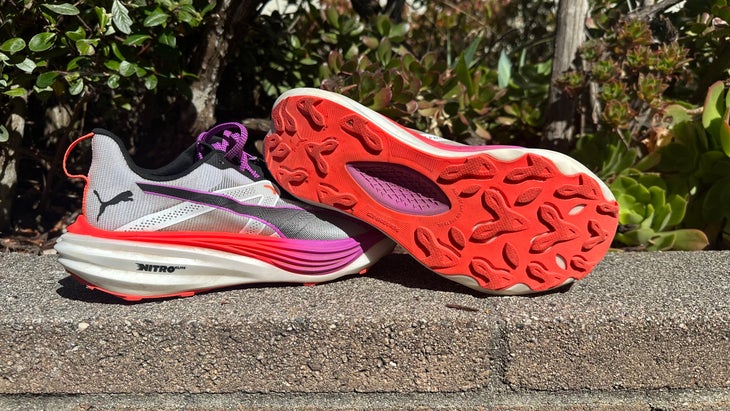
Puma Deviate Nitro Elite Trail
$230 at Running Warehouse (Women’s) $230 at Puma (Men’s)
Weight: 8.6 oz (men); 8.6 oz (women’s 9)
Stack Height: 37-31 mm
Drop: 6 mm
Pros and Cons
⊕ Lively midsole
⊕ Agile in technical terrain
⊗ Narrow-volume upper
If you’re thinking, “Wait, PUMA makes trail running shoes?”—you’re not alone. When we first saw the Deviate Nitro Elite Trail at the 2024 Running Event, we were also surprised. But our shock quickly turned into excitement as we picked up the shoe. Built off PUMA’s Deviate Nitro Elite road series, this trail version features an A-TPU midsole that’s nimble, lively, and makes you feel quick-footed and agile. A-TPU is quickly becoming the preferred midsole over PEBA for high-end racers.
Compared to other trail super shoes, the stack is on the low end, giving it better ground feel and control. We had no issues navigating technical terrain, and would recommend this as the best plated trail shoe for tricky terrain.
My one gripe was the fit; it ran on the skinny side, feeling tight and compressed through the midfoot. That said, the secure lockdown gave the shoe a dialed-in feel that complemented the midsole, making picking through rocky terrain feel even more precise and confident. However, it lacked the space to let the feet splay during extended runs, causing us to think twice about it for really long outings.
PumaGrip ATR rubber on the outsole with shallow 3 mm chevron lugs sticks admirably to dry rock and hardpack and performed well on door‑to‑trail outings, but left something to be desired in situations where digging in to get a firm grip was needed.
For short, quick trail runs in rocky or hard-packed terrain, these made us feel like we were flying.
How to Choose the Best Trail Running Super Shoes for You
Consider the Terrain
Before narrowing in on a specific trail shoe, it’s important to understand the type of running you’ll be doing, more specifically, what the terrain will look like. Will it be rocky and technical, or smooth, hard-packed dirt? How long will you be running? How fast will you be going? Your answers to these questions will steer you towards certain types of trail shoes.
For example, if you’re running mostly on technical, uneven terrain, you’ll likely benefit from a lower-profile, more agile shoe that offers better ground feel and precise foot placement, rather than a high-stack model that can feel unstable or tippy.
This is especially true for plated trail shoes. While they excel on smoother, rolling terrain where their cushioning and propulsion shine, they can feel wobbly on off-camber or highly technical surfaces due to their higher stack height and added stiffness from the plate.
Fit and Comfort
Once you’ve identified the type of trail running you’ll be doing and narrowed it down to the appropriate category of shoe, it’s time to try on a few pairs. Fit and comfort are by far the most important factors when choosing a trail shoe.
In most cases—aside from shoes intended for ultra-long distances where foot swelling is a concern—you’ll want a secure, snug fit through the midfoot. Trail running often involves quick direction changes, lateral movements, and uneven footing. If the shoe is too loose, your foot may slide around inside, which can compromise control and increase the risk of blisters or rolled ankles. You should be able to cinch the laces tight enough that your foot feels locked in from the instep to just behind the ball of the foot, with no movement inside the upper, yet you should still feel comfortable when fully secured. A proper fit balances control and all-day wearability.
Trail Running Super Shoes FAQ
Will a plate make technical trails riskier?
It depends on the kind of plate. Trail shoes have featured flexible nylon “rock plates” for years—they simply block sharp stones from bruising your feet. The latest wave swaps that supple shield for a stiffer carbon layer meant to boost propulsion. Brands often fork or segment these carbon plates so they can still flex with uneven ground. Even then, however, when you pair that stiffer plate with a tall stack of foam, you end up sitting on top of a wobblier platform that can feel sketchy in technical terrain.
Can beginners or intermediates benefit from plates, or are they only for elites?
While there is some research that trail running super shoes with a plate combined with a high-energy foam only enhances performance at faster speeds, anyone can benefit from them. The number-one most important thing when picking a running shoe is comfort and fit. Plated shoes are usually paired with more premium foams that offer better cushioning and energy return. As long as the shoe feels comfortable, particularly if it matches your gait at running speeds, you may benefit from the added cushioning and energy return.
Why are trail running super shoes so expensive?
Plated trail shoes are more expensive because nearly every ingredient in them costs more than what you find in a standard trainer. The two main drivers are the plate and midsole. The plate, which is usually made of carbon fiber, is precisely engineered with unique flex patterns to enhance propulsion. The midsole, meanwhile, uses a more expensive foam and often dual‑density constructions, which run two-to-three times the price of ordinary EVA.
